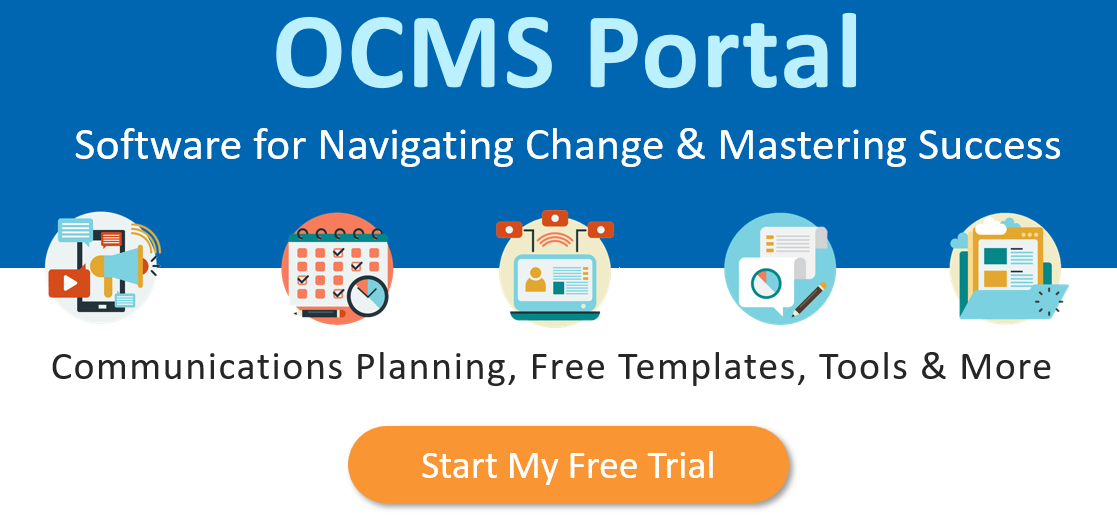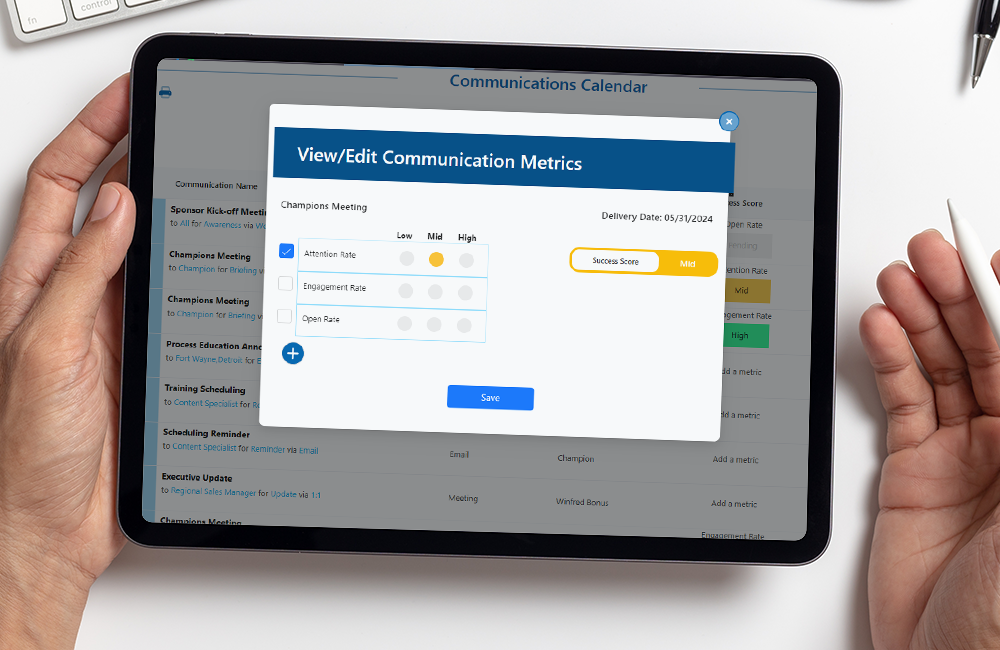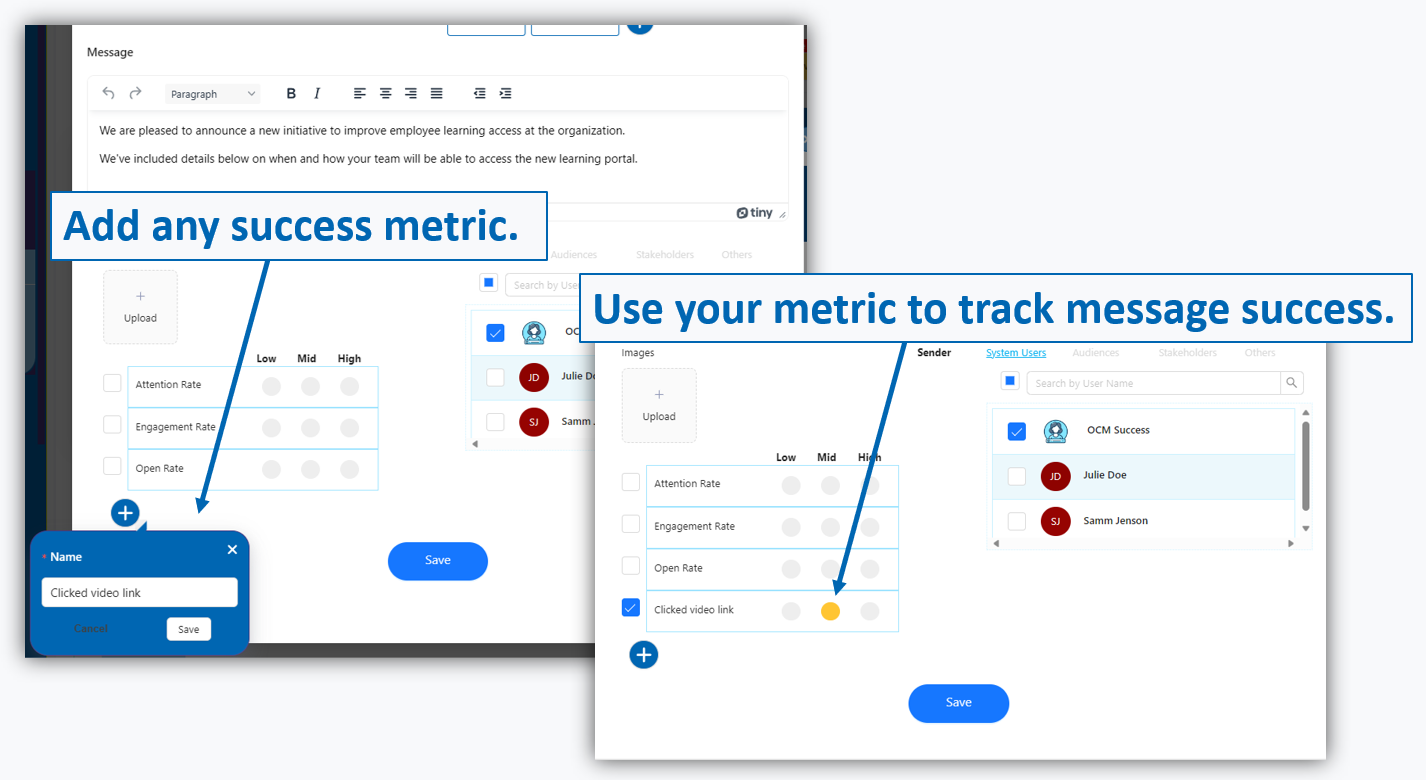End-to-End Internal Communication Strategy
Unlock the Secrets of Seamless Internal Communications
Keeping your team engaged, informed, and motivated can be a game-changer for productivity and the success of change initiatives. In times of transformation, clear and transparent communication is the glue that holds teams together. It ensures that everyone within the organization understands the changes, the reasons behind them, and how they fit into the bigger picture. When employees are well-informed, they feel valued and engaged, leading to increased morale and a more positive attitude towards change.
Effective internal communication planning plays a pivotal role in the success of organizational change initiatives.
In this article, we’ve curated the best practices, internal communications plans, and innovative templates to help you craft communication strategies that truly resonate.
Best Internal Communications Software
Get instant access to over 100 free templates, tools, and resources when you sign up for a trial of OCMS Portal. This includes several internal corporate communications email templates.
Read our quick topic summary on internal communication management below. Then, keep reading after the summary conclusion to explore the topic in more detail.
Quick Summary
The Importance of Internal Communication Planning
Good internal communication fosters a sense of trust between leadership and staff. Open channels of communication allow employees to voice their concerns, ask questions, and contribute their ideas, creating a collaborative environment where everyone feels heard.
This inclusivity not only eases the transition process during change initiatives, but also sparks innovation, as diverse perspectives are encouraged and acknowledged.
Ultimately, a well-thought-out internal communication strategy mitigates resistance and also paves the way for a smoother, more successful implementation of organizational change, ensuring that the entire workforce is aligned, motivated, and ready to embrace the future.
Getting Started with an Effective Internal Communication Plan
Creating a robust communication plan begins with a deep understanding of the project’s goals. This involves interviewing project or marketing leads, attending relevant meetings, and grasping key points and existing branding.
Crafting concise messaging pillars based on project objectives provides a consistent foundation for communication strategies. These pillars, emphasizing core aspects like efficiency or innovation, serve as a guide for the communication plan. Importantly, these messaging pillars should align with the target audience, ensuring tailored communication.
Identifying the Audiences for Internal Communication in an Organization
Identifying the target audience is vital, differentiating between internal and external groups. Internal audience engagement could range from employees to executives, necessitating various levels of communication.
For external audiences, such as customers or suppliers, tailored messages are crucial. The process involves conducting assessments, reviewing project documents, and collaborating with stakeholders to compile a comprehensive list. Once the target groups are identified, this information can be structured using communication templates, ensuring a systematic and effective communication strategy.
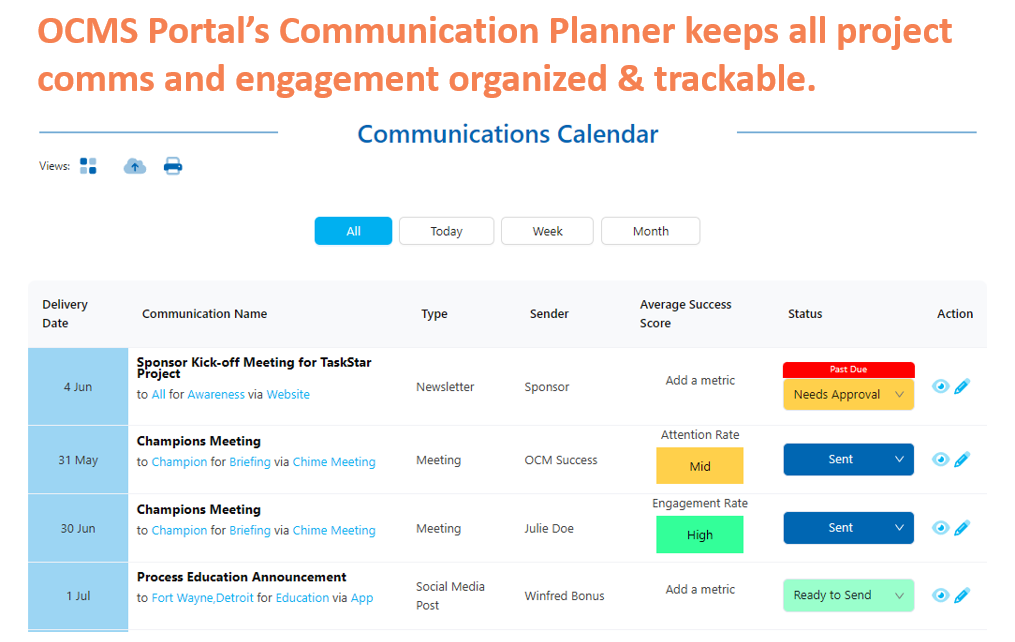
Use internal communications best practices and keep all change management engagement and internal comms in one place. Try our Communications Tool, part of the OCMS Portal change management software, by signing up for a free trial today.
Example of Internal Communication Steps
When managing internal business communication for a project or change initiative, here are some of the typical steps you’ll take after identifying internal audiences.
Setting Communication Objectives
- Determine specific messages for different internal and external groups based on their impact level.
- Define communication objectives: What do you want your audience to do, and how should they act?
- Tailor communication based on organizational tone, consistent style, and known rhetoric tools.
Prioritizing Audiences and Communication Types
- Prioritize audience engagement based on their level of impact by the project.
- Classify communication types into categories such as announcements, compliance, educational, and scheduling.
- Determine communication priority, with initial awareness being high priority and follow-up resources often low priority.
Choosing Effective Communication Channels
- Adopt a multi-pronged communication approach, combining online (social media, email newsletters) and offline (in-person meetings, postcard mailers) channels.
- Assess existing company delivery channels and target audience preferences to finalize the list of communication channels.
- Implement a mix of channels, such as email, newsletters, two-way communication, FAQs, intranet/blog posts, videos, and social media, to ensure comprehensive coverage and engagement.
Do you have any questions about internal communication definition or how to Google internal communications and get the answers you need? Reach out and let us know.
Measuring Internal Communications Success
Creating and analyzing communication success metrics is pivotal in evaluating the effectiveness of any communication strategy. By defining clear and measurable metrics, organizations can assess the impact of their messages and make data-driven decisions.
These metrics can encompass various aspects, such as audience engagement, message reach, response rates, and even changes in employee behavior or attitudes.
By employing tools like surveys, feedback forms, website analytics, and social media metrics, organizations can gather valuable data. Analyzing this data provides insights into what works and what needs improvement, allowing communication teams to refine their strategies.
Success metrics help demonstrate the tangible value of communication efforts, helping organizations understand the return on investment and enabling them to continuously optimize their communication approaches for maximum impact and resonance.
Conclusion | Internal Comms Strategy Guide
Remember, communication isn’t just about words; it’s about building bridges, fostering trust, and creating a vibrant workplace culture. By implementing the strategies, tips, and techniques shared in this guide, you’re not just enhancing how information flows – you’re strengthening relationships, boosting morale, and driving your organization towards success.
As you put these insights into action, always stay open to feedback, adapt to the changing needs of your team, and keep the lines of communication wide open. Wishing you all the best in your communication endeavors!
PS: If you’d like to know more about how to improve internal communication for a change initiative, keep on reading for a detailed deep dive.

Detailed Deep Dive
Complete Internal Comms Guide | Get Internal Communication Examples, Templates, and More!
This free internal communication plan guide provides you with everything you need to know for planning and delivering effective internal communications strategies to increase your engagement successes.
It references key internal communication examples that you can leverage, and also samples that you can follow.
Table of Contents – Everything You Need to Know
Continue scrolling down to read a more detailed overview of the best internal communication strategies, plans, and templates, or click any link below to go directly to that section.
- Internal Communication Definition
- What Is the Difference Between Waterfall & Agile Internal Communication Plans?
- First, Define the Project Purpose for Your Company Internal Communications
- Create Your Internal Communication Strategy Messaging Pillars
- Identify the Target Audience Lists for Your Internal Comms Plan
- Specify the Objectives for Your Employee Communications Strategy
- Define Internal Communication Types for Your Campaign
- Best Multi-Prong Internal Communication Channels for Your Target Audiences
- Define Your Internal Communication and Employee Engagement Schedule
- Create Messages for Your Employee Engagement Communication Plan
- Detail Performance Tracking Metrics for Internal Communication Management Plan
- Implement Your Strategic Communication Plan Template
- Analyze & Optimize Your Internal Employee Communications Plan
- OCMS Portal Internal Comms Tool: Internal Communication Examples (with Success Metrics)
- Messaging Templates & Samples for Your Internal Communication Strategy
- Communication via Newsletter | Sample & Template
- Two-Way Communication Strategy
- 3×5 Leadership Communication | Sample & Template
- FAQs – Internal Communication Employee Engagement
- Internal Communications Intranet/Blog Communication
- Videos & Recordings Strategy to Include in Your Internal Communications Plans
- OCMS Portal’s Internal Communication Strategy Tool and Free Internal Comms Templates
- Conclusion – Example of Internal Communication Plans & Templates
OCMS Portal with Internal Communication Management Tool and Real-Time Analytics
Improve your communication skills assessment and planning with templates, sample data, and reporting insights.
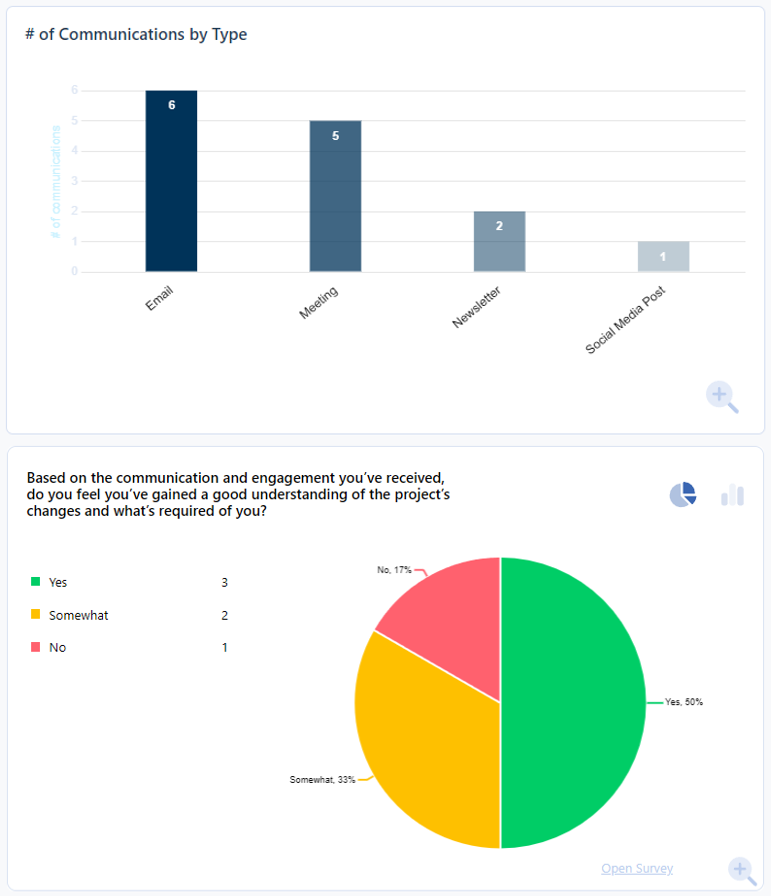
The OCMS Portal change management software has communications tools and reporting to improve your internal corporate communication strategy. Start a free trial today!
Do you have any questions or feedback about the internal communication types referenced in this document? Send us a message, we’ll love to hear from you.
Internal Communication Definition
Internal communication, in essence, embodies the vital essence of organizational connectivity. At its core, the internal communication meaning lies in the art of cultivating seamless dialogue and fostering a sense of unity among an organization’s members.
It transcends mere information dissemination; it’s about building a robust network where ideas, knowledge, and inspiration freely flow. By embracing effective internal communications strategy examples, businesses create an environment where employees are not just recipients of information, but active participants in the company’s journey.
Another way to think about internal communication definition and internal communication meaning is by looking at the difference between internal communications and external communications.
- Internal communications: Encompass employee engagement and communication. It means communicating within the organization.
- External communications: Encompass customer or vendor communications. It means communicating with groups or individuals outside the organization.
What Is the Difference Between Waterfall & Agile Internal Communication Plans?
When seeking out a plan for internal communications tactics, you might wonder if there’s a difference between a waterfall and Agile communication plan.
The steps that you take to plan effective internal communication strategies will be similar, but with an Agile communication plan, you’ll be repeating the same types of online communications and offline messaging for each sprint.
How to make a communication plan for each type of approach will be outlined in the sections below.
Waterfall Communication Plan Outline
The waterfall project approach follows sequential steps from start to finish. Thus, most of your awareness communications for a project would come in the beginning, and your post-go-live messaging would come at the end.
Agile Communication Plan Outline
The Agile project approach is iterative. The project is divided into smaller parts called “sprints.” For each sprint, you would repeat the cycle of your communication plan template.
Sprint 1 would include the most planning, and you would create a project communication plan sample template that could then be leveraged during Sprint 2, Sprint 3, and so on. You also should take lessons learned from earlier sprints to continually improve your communication and messaging activities.
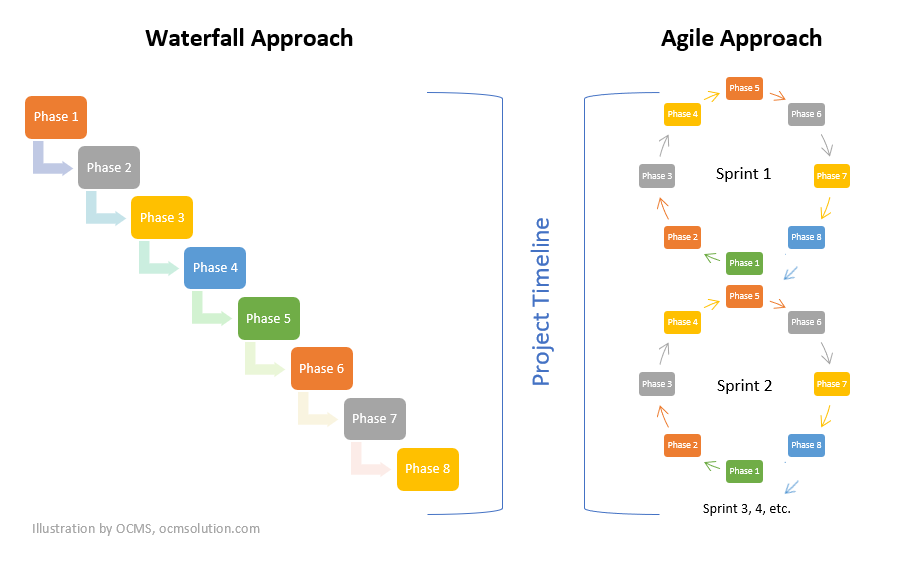
Communication guidelines template differences of Waterfall and Agile approaches.
► OCMS Portal with Comms Tool & Free Employee Engagement Communication Emails
First, Define the Project Purpose for Your Company Internal Communications
Before you can get started on any communication assessments for your plan, you need to thoroughly understand the project that requires a communications campaign.
If you haven’t done so already, you’ll need to interview the project or marketing leads to learn about the goals and purpose of the project. It’s important to learn as much as possible so you can both lay out your example of online communication messages, and also ensure your messaging is on point with the goals of the project.
For a change management project, this may mean asking to sit in on some project-related meetings and meeting with the project/change team to ask questions that allow you to put together a communication guidelines template for the project. Or meeting individually with the project managers and program leads.
In the case of writing a communications plan for a promotional, marketing, sales, or event project, this may mean meeting with the marketing, event, or sales team to fully understand the project objectives.
Your goal is to understand the key points that need to be communicated and whether or not there is specific branding already in place for the project that needs to be incorporated into your messaging.
Create Your Internal Communication Strategy Messaging Pillars
It’s helpful if at this point you create messaging pillars based upon the project goals and objectives to inform your sample communication plan for events, change transformation, or sales/marketing projects.
Messaging pillars are 3-4 major selling points of a company, project, product, or another subject of a communications campaign. They are used as a base for your communications plan template and all campaign messaging. Companies with great internal communications ensure that all have a consistent message and strategy, revolving around the messaging pillars.
Using messaging pillars to guide your content creates consistency throughout your strategic communication plan template.
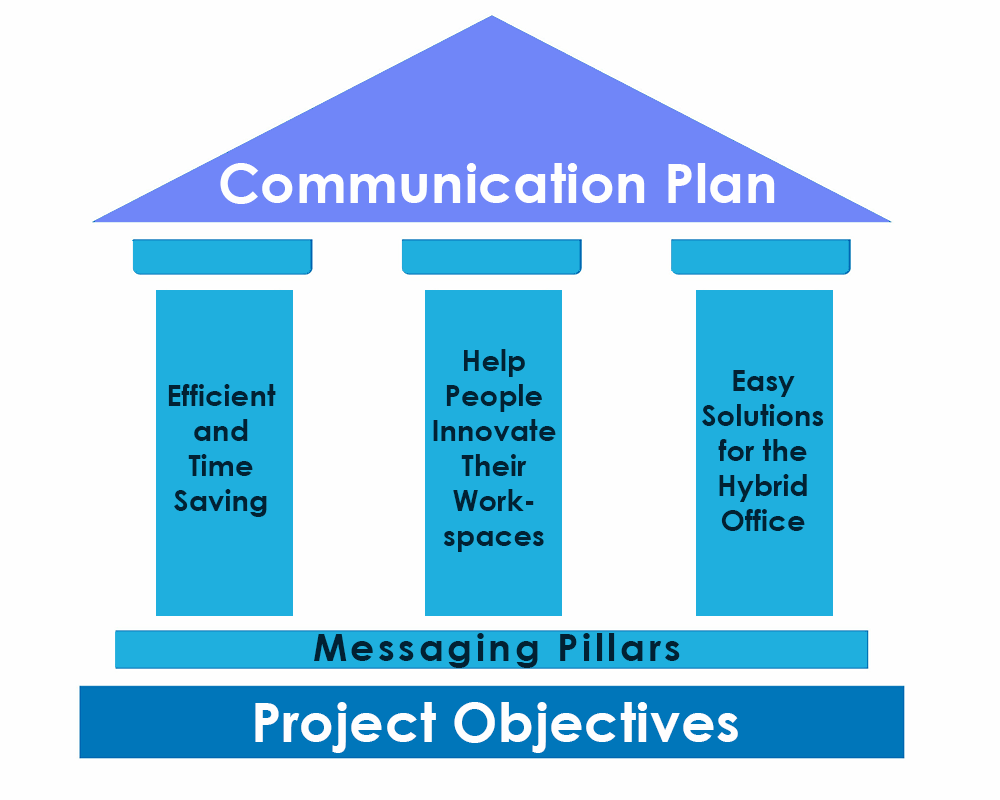
Sample communication strategy and plan messaging pillars for a software enhancement project could be:
- Focused on efficiency & time-savings
- Our brand delivers innovation to help others innovate their workspace
- Easy solutions for the hybrid office
Communications teams should incorporate the key points of the messaging pillars in various ways throughout their messaging campaigns. Messaging pillars should not be too long. Keep them to one short sentence or point.
When creating your internal communication examples, remember that messaging pillars can differ according to the target audience. So, consider this when doing your communication assessment for each audience.
Identify the Target Audience Lists for Your Internal Comms Plan
There are two main types of target audiences in a strategic communications plan example: Internal and External.
Some communication practitioners will deal with only one of the target audience types: internal audience groups. Internal communication is a communication between those inside a company, such as employees, managers, and executives. The level of communication in an organization project plan will dictate how many internal audience groups you engage with.
Others will need to engage with both internal and external audiences in their sample communications strategy. External audiences include those outside an organization, such as customers, clients, suppliers, vendors, leads, etc.
An example of online communication campaigns that might incorporate both groups would be an upgrade to a CRM platform that includes live chat.
1. An internal audience (for example, your firm’s customer support team) would need to receive communications about the new CRM. This would include awareness, training, and similar messaging included in a stakeholder communication plan example.
2. An external audience (for example your firm’s customers and external stakeholders) may need to receive communications telling them that they can now chat live and how to get help.
Use the steps below to identify a complete target list for your internal and/or external audience groups.
How to Identify Internal Communication Target Audience Groups
1. Meet with the project management team to review the change impact assessment, if they have already conducted it. This is an assessment that identifies the company groups being impacted at any level by the project. These groups will need to be part of your communication and engagement plan example.
2. At this time, it’s also helpful to request the Project Roadmap, which outlines the timing of each project task or event, so you know when each group is being impacted.
3. Do an internal target audience assessment. This is an assessment of all internal groups that need to know about the project. Anyone being impacted in any way or that requires updates on the project should be included in your communication plan matrix example.
4. Next, you’ll want to request (or conduct yourself) a stakeholder audience assessment to identify key group representatives and leaders that will be impacted by the project or by the change. Add these individuals to your list.
5. For a communication that is driven by a business change, meet with project sponsors, key stakeholders, project managers, and other project resources to gather additional information on who else will be impacted by the change, and also gather a high-level summary of what these additional individuals and groups need to know.
6. Review project documents including the project charter, work breakdown structure and project plan to see if you can identify any additional groups that need to be communicated with and added to your team communication plan.
7. For company information or business crisis information, the target audience will involve any group that needs to be aware of this information.
8. For marketing, promotional, or other internal campaigns, the audience will be the managers and employees for groups that need to be aware of the campaign’s messaging.
9. The target audience for communications from firm leaders will be those groups that need to be aware of such leadership communications. Such communications can be messaging broadcasts to motivate staff, increase productivity, or promote a change in the company’s culture.
After completing your assessments and identifying your complete communication target list, you can enter that information into the OCMS Portal’s Communication Management Tool or your own communication spreadsheet or template.
OCMS Portal with Best Internal Communications Tool
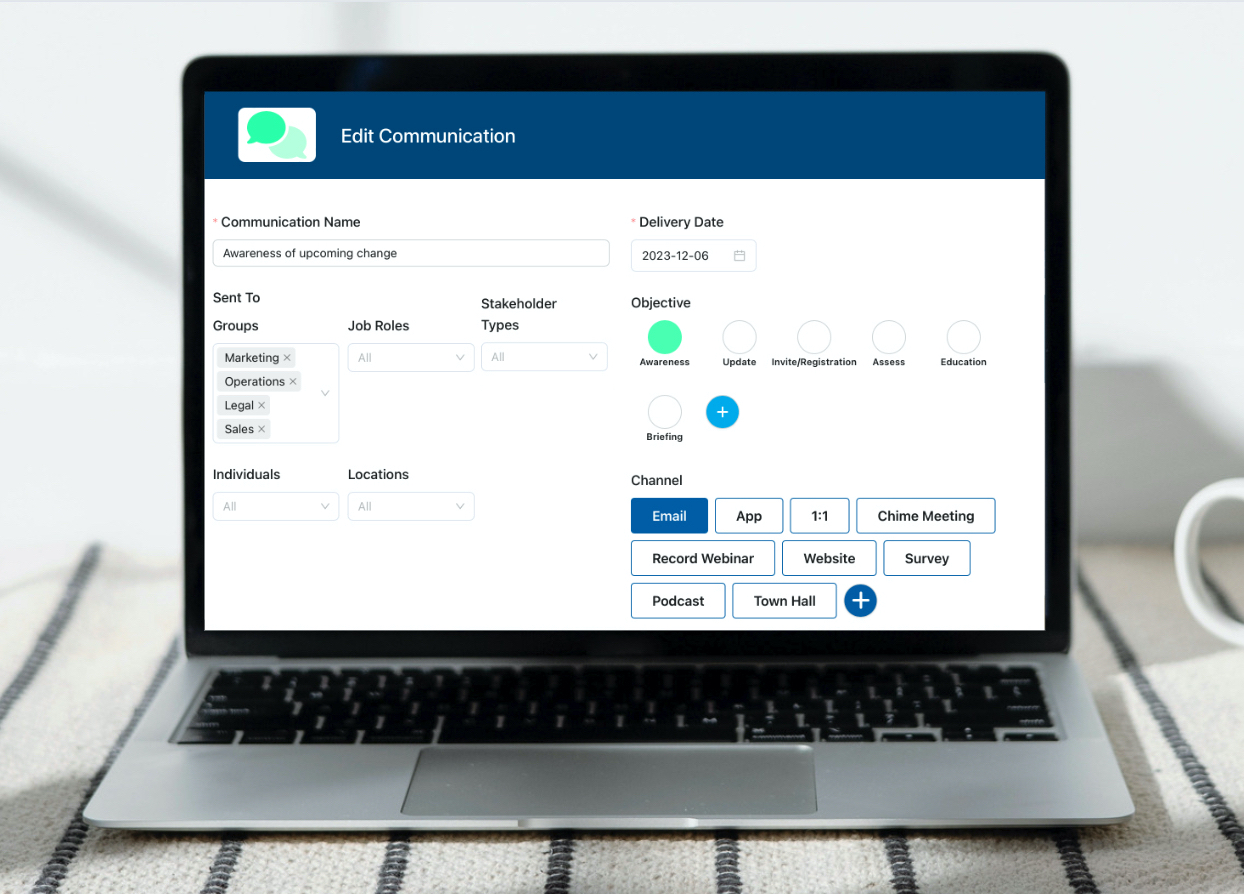
How about improving internal communications in the workplace? OCMS Portal’s Communication Management Tool makes it easy to add, monitor and track the success of your internal communication strategy. Sign up for a free, no-risk trial today to experience change management simplified!
How to Identify External Communication Target Audience Groups
1. To begin identifying the external audiences you’ll be communicating with, you should meet with the project management team or marketing/sales/event team for their input on who you need to communicate with.
2. Review target audience demographics (these narrow down which specific groups are being targeted for communications and helps you with targeting) Learn more: Target Audience Assessment.
3. Review the project/event timeline so you understand when external target audiences need to be sent messaging.
4. Do an external target audience assessment. This is a communication assessment of all external groups that need to know about the project. Anyone being impacted by projects or targeted for sales, events, or other engagements should be included in your comms plan example.
5. Some of the things you can gather when assessing a project, sales campaign, or event for external target audiences are:
- Demographic details (household income, age range, occupation, etc.)
- Psychographic details (opinions, needs/concerns, personality traits, etc.)
- The priority level for this audience
- Buying statistics
- Keywords to use in messaging for an audience
Depending on what your organization needs to communicate, your external communication audience groups added into your communication plan sample template may include:
- Existing customers that have purchased your firm’s products
- Existing clients that are using your firm’s services
- Leads (potential new customers and clients)
- Vendors
- 3rd parties
- Suppliers
- Consultancies providing services to your organization
- Partners
- Shareholders
- Distributors/Resellers
- and many more…
Don’t Miss: ► ► Top Ranked Change Management Software with Internal Downward Communication Planning & Mgt Tool
Specify the Objectives for Your Employee Communications Strategy
Now that you know who you are communicating with, you next need to determine what needs to be communicated to each group. When doing communication assessments, you’ll find that some internal and external groups will need different types of messaging.
What is a internal downward communication plan for one target audience might look very different than that for another audience.
For example, an internal group that is being highly impacted by a change project will need more engagement, and messaging that focuses heavily on the benefits to the group to help mitigate resistance.
A less impacted internal group that may only be slightly impacted due to a small process change, on the other hand, may instead need less messaging overall, and communication that focuses most on the process change itself.
What needs to be communicated and how this will be communicated will be determined as part of your communication objectives. In order words, what do you want your communication audience to do? What actions do you want them to take?
Is this just a simple awareness or are there things you need your audience to do?
How to communicate? See the below sections for a detailed overview of the various communication channels you should leverage for your project communication plan example.
What to communicate? This varies across organizations and is on a case-by-case basis. What you will be communicating will be driven by your communication objectives.
Sample Communication Strategy and Plan Objectives:
1. Provide awareness about the changes
2. Targeted to identified audiences and distributed at pre-determined dates
3. Interactive to maintain interest, participation, and opportunities for learning
4. Based on known rhetoric tools and adapted to each impacted organization’s “tone of voice”
5. Consistent tone & style across communications
6. Consistent messaging
Prioritize Audiences for Engagement & Frequency
While defining your key messaging objectives for your internal organisational communication audiences, you should also think about their priority. This helps when you are creating your messages for your project communication plan sample draft.
Audiences that are highly impacted by a project will typically require a higher frequency of communications and will have more high-priority communications.
Audiences that are simply being kept updated on a project, but aren’t directly impacted, may receive fewer communications and have a lower priority.
How to make a communication plan priority decision?
Prioritizing internal communication in the workplace will depend largely on your audience objectives and other project/event details. A few general tips:
- Initial awareness communications are usually high priority
- A secondary or reminder communication might be low or mid priority
- Emails about scheduling webinars, signing up for training, etc. are typically high priority
- Emails providing follow-up resources that people have already received during a meeting might be low priority
Easily track whether employee engagement communication emails are hitting their mark. OCMS Portal’s Internal Office Communication Tool puts the power of customized metrics in your hands.
Sign up for a free trial today and check it out!
Define Internal Communication Types for Your Campaign
It’s helpful if you group your communications by “type.” This keeps your internal communications strategy better organized and also helps you with prioritization.
Internal communication examples of different types include:
- Advertising
- Announcements/News
- Awareness
- Compliance
- Educational
- Leadership Updates
- internal upward communication
- internal downward communication
- Post-Go-Live
- Pre-Go-Live
- Corporate town hall meetings internal communication
- Process Changes
- Scheduling
- And more
Best Multi-Prong Internal Communication Channels for Your Target Audiences
It is strongly recommended that you include a multi-prong internal communications strategy when developing your communication plan and ensure that you are using different types of online communication, and offline communication (if applicable).
An example of online internal comms channels for delivery would be social media posts, internal messaging app (like MS Teams or Slack), pay-per-click advertising, email newsletter, company blog, virtual meeting, etc.
An example of offline internal comms channels would be in-person meetings, postcard mailers, and tradeshows/events.
Steps for choosing your internal communication channels:
1. Do communication assessments for company delivery channels currently used or that have been used in the past.
2. Do a communication assessment of your target audiences for channels they may prefer (a new social media or cloud app) and add any that would help increase success.
3. Finalize your list of delivery channels and enter them into your communication planning template.
TIP: Apply at least 4 of the communication channels listed below. Companies with bad internal communication don’t use enough channels and risk communications not reaching all audiences. Companies with good internal communication send messages over more than one or two different channels.
Communication Delivery Channels
1. Email
2. Newsletter
3. Two-Way Communication (team messaging, in-person or virtual meetings, live chat, etc.)
4. 3×5 Leadership Communication
5. FAQs
6. Intranet/Blog Communication
7. Videos & Recordings
8. Social Media
Do you have any questions about the good internal communication? Please reach out and let us know.
Define Your Internal Communication and Employee Engagement Schedule
Review the project timeline and/or campaign timing to draft a communication schedule. Your communication schedule should include a Start Date and End Date for the messaging campaign.
Some communications that are only sent once may have the same date for start and end date on a corporate communications plan schedule. But many messaging campaigns are sent out over a specific timeframe. In this case, it’s important to know both the start and end dates for that specific message.
Attaching these dates allows you to keep track of when you need to send out communications. Using a reporting dashboard like the one in the OCMS Portal’s tool to manage internal communication in an organization can also show how different types of communications from multiple projects are impacting an audience.
For example, you’ll be able to cross-reference communications from Project “A” that might be going to the same group on the same day as Project “B.” This cross-referencing is important if your organization has several projects that overlap, as you don’t want any messages getting lost in the mix because users are overloaded with too much incoming information.
Create Messages for Your Employee Engagement Communication Plan
What is a communication plan without messages? The next step in putting together a stakeholder communication plan example or external audience communication plan would be to put together the messages themselves.
In the case of an email, you can enter your subject line and message text in your communication plan template. For virtual meetings or events, you can just include the main points that are to be covered in your messaging tracking template.
Because there are many levels of communication in an organization, you’ll want to be sure to include details along with your messages, such as tasks that need to be completed, message priority, audience being sent the message, and other helpful notes.
Get Free OCM Email Templates, Downloads & Internal Communication Examples
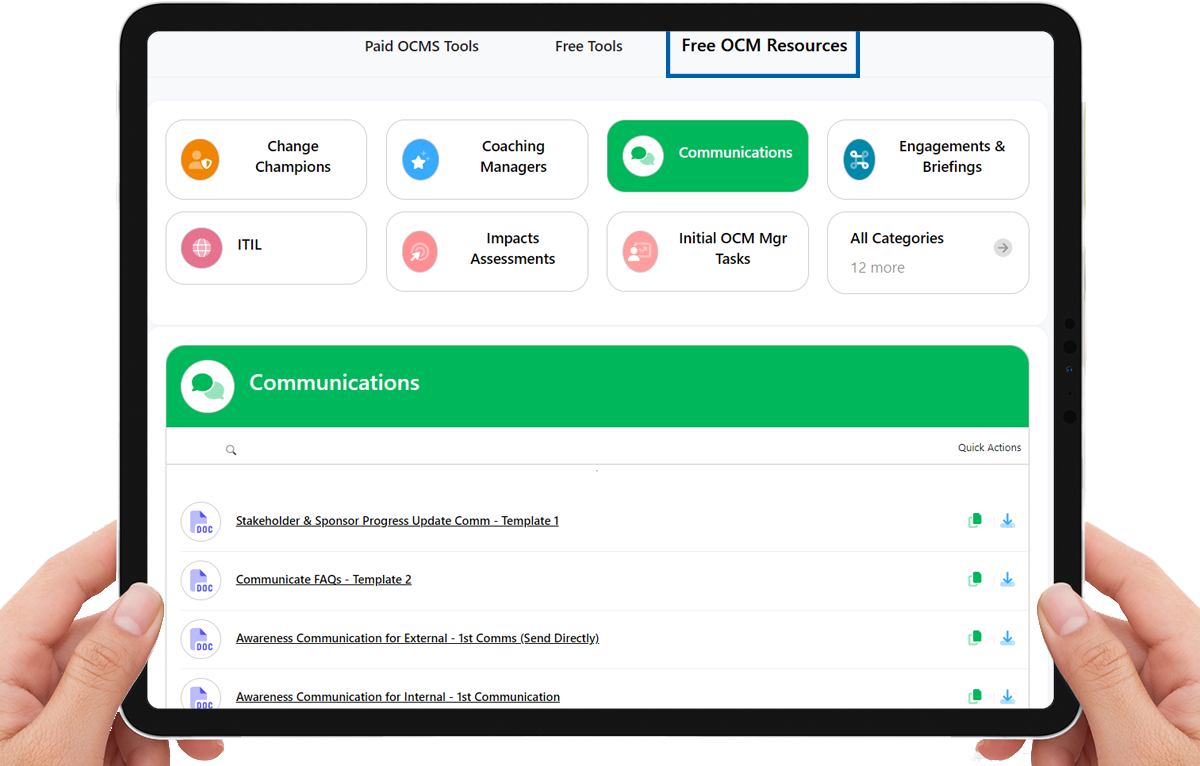
Looking for free email templates and internal communication strategy examples? Sign up for a Free Trial of OCMS Portal and access state-of-the art Change Management Software, internal business communication templates, and over 100 other resources.
Detail Performance Tracking Metrics for Internal Communication Management Plan
To properly assess the engagement success level of your messaging you need to come up with the targets or KPIs you’re going to use as your measurement of success.
Review your communication plan objectives examples and set clear and measurable goals using quantitative measurements. It’s also better to have more than one measurement if possible. This provides a more robust set of KPIs that cover multiple engagement activities.
Some possible ways to measure engagement success in your business communication plan example:
- Open or click rate for an email.
- Whether participants took the desired action the message directed (i.e., setting up login credentials with a new cloud tool or making a purchase)
- Engagement with a post (Likes, Shares, Comments, etc.)
- New customer/lead acquisition count
- Number of registrations or new sign-ups
- Number of surveys being returned
If you’re using the OCMS Portal’s internal communications plans tool, then it’s easy to define and track KPIs for each type of communication and engagement. These generate a success score, which makes it easier when it’s time to evaluate your campaign performance.
Communication Campaign Performance Tracking in OCM Solution Communications & Messaging Toolkit
Using KPIs and engagement success scoring in the OCMS Portal’s internal communication management tool gives you insightful and actionable data to make your messaging campaigns more effective.
Implement Your Strategic Communication Plan Template
Next, you’ll be implementing the messaging from your strategic communication plan template.
While implementing your communications plan, you’ll want to identify any issues and correct these as soon as possible to keep your messaging on track.
Follow-up and attention to detail are important qualities to look for when doing a communication skills assessment when choosing your team members for each task.
Be proactive and check on message delivery regularly to ensure your campaigns are going out smoothly. For example, if you know right away that an email wasn’t sent out successfully, you can quickly remedy the situation and resend rather than having your audience miss an important project communication.
If any timing details change for a project that impacts your communications, you will also want to stay on top of this so messages can be edited or rescheduled as needed. You may want to designate one person on the communications team to be responsible for timeline/message changes.
Analyze & Optimize Your Internal Employee Communications Plan
It’s important to continually optimize your corporate communication plan example to improve success. You do this by evaluating your campaigns and looking at what went right (successes) and what could be improved upon.
Do this throughout your project, not only at the end. For example, if you are doing an Agile communication plan, you could evaluate at the end of each sprint and continually optimize your messaging based upon the past sprint’s performance.
Do you have any questions about internal communication meaning or how to access a good example of internal communication? Just reach out and let us know.
OCMS Portal Internal Comms Tool: Internal Communication Examples (with Success Metrics)
Do you want to improve internal communication for your change initiative? Plan, track, score, and assess communications easily using the Communications Tool in the OCMS Portal. Get a free communication feedback survey, tons of free internal corporate communication email templates, and the freedom to customize communication types, internal communication channels, and more.
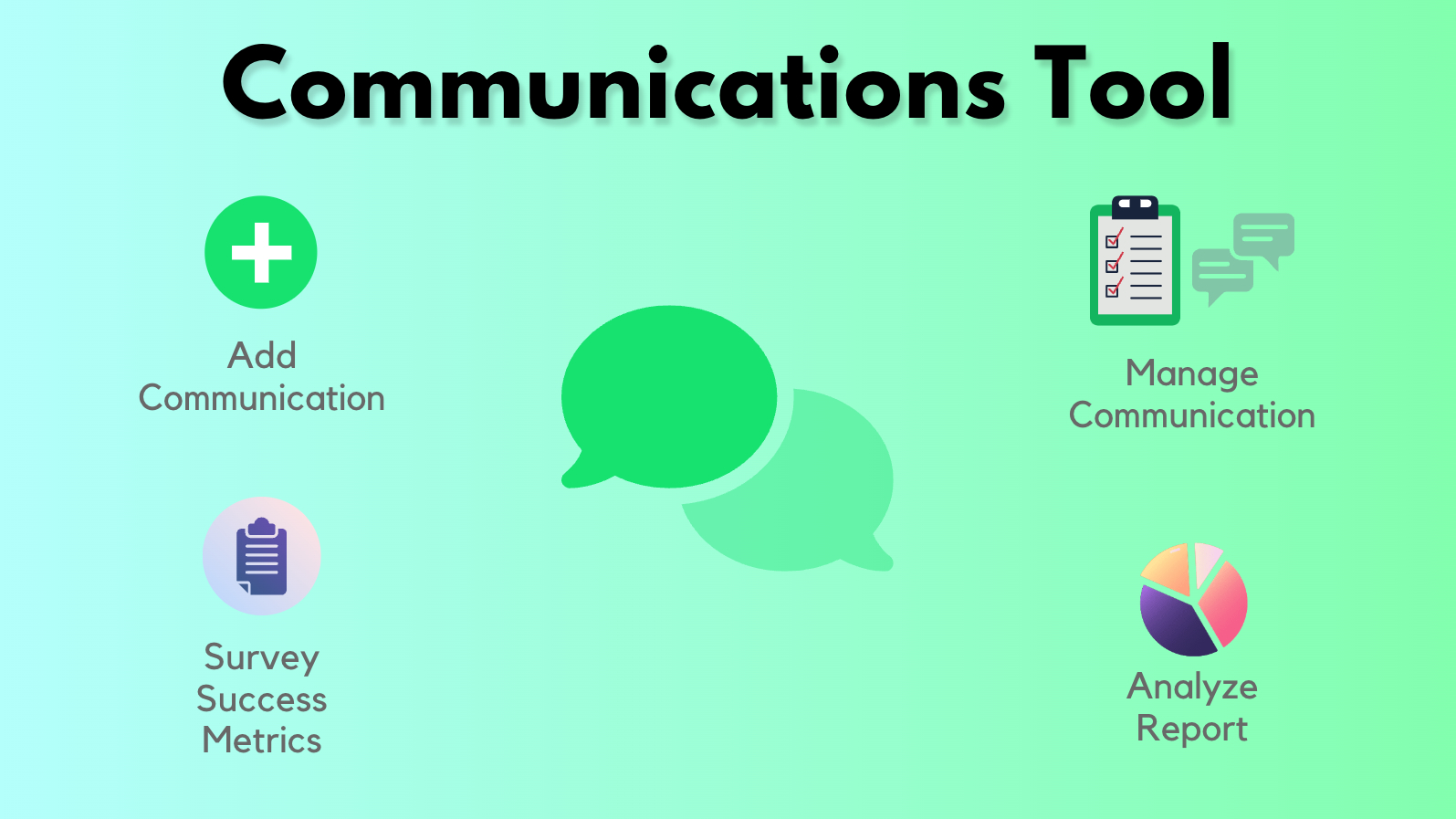
Improve Your Communications Planning Today!
Sign up for a Free Trial Today!
Messaging Templates & Samples for Your Internal Communication Strategy
Following are some project communication plan example messaging templates and samples to give you some guidance for your own communication planning.
Communication via Email | Sample & Template
Depending on the global or regional scope of your target communication audience, email will be the primary communication channel you will use to broadcast your communications.
Outlook has a feature that allows you to track when someone opens and reads the email. However, the reader has to first click “Yes” on a pop-up asking them to allow tracking. Unfortunately, most people will click no.
To more effectively track the success of your email communications, it is recommended that you use a 3rd party tool or an Outlook extension.
Your company (e.g., your HR department or Corporate Communications) most likely already has such a tool you can use to broadcast email communications, plus track metrics like open rates, number of people that “clicked on links within the email”, how much time people are spending reading the email, number of times the email was forwarded, and other trackable metrics.
These metrics can also be tracked for your sample communication strategy and plan by using cloud email delivery tools (MailChimp, Constant Contact, etc.) or by using specific features of certain CRM programs.
Structure & Format to Use for Your Email Communication
How should you structure and format your communication broadcast message?
We recommend that you break up your email message into segments – paragraphs and bullet points. People don’t like to read long lines of text messages in an email. Bullet points and short paragraphs are best practices.
It’s also helpful to include a consistent header image and signature for each communication, so recipients can immediately identify it as being from the relevant organization and related to the specific project for which you’ve created your strategic communication plan template.
This consistency can extend to the “From” address for emails as well. Keeping email communications consistently from the same email sender is helpful if users would like to set up email rules that will flag incoming messages from that address. You might want to make this suggestion to your internal audience, so messages don’t go to spam folders.
Sample Email Communication Template
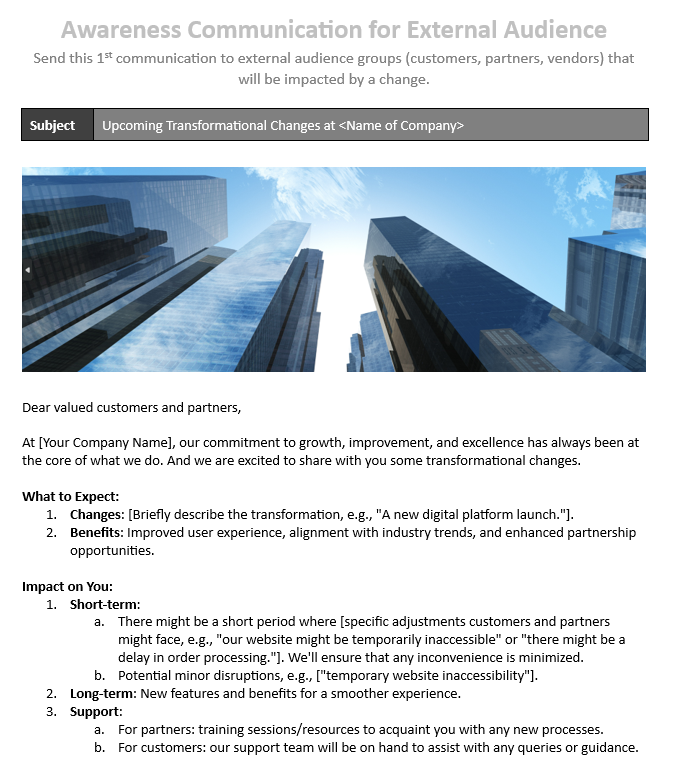
Get this template and many others in the Free Resources section of the OCMS Portal. Access them now by signing up for a Free Trial.
Benefits of Email Awareness Communications
Regular email awareness communications and status update emails are essential for engaging with communication groups. It is a vital way to communicate with your internal audience (company employees and managers) or external audience (customers, suppliers, vendors, etc.), especially those that are directly impacted by a business change or need to know about an event.
Awareness and status-update email communications are effective for providing employees and customers with a good understanding of what is changing, what are the benefits, and what’s the risk of not changing, as well as keeping end-users engaged throughout the duration of a change.
► End-to-End Tool to Manage OCM and Your Communications

Is there a best internal office communication that you have used that you would like to share with other project managers and change leads? Please, reach out and let us know.
Communication via Newsletter | Sample & Template
People generally skim through communications, without really taking the time to read every word. As such, using a newsletter format, which involves succinct messages and images is an important communication delivery channel that should be part of your comms plan.
When available, also add embedded videos or video links to your newsletters. Forty-eight percent of surveyed employees consider video the most engaging form of communication.
Leveraging newsletters as one of your communication delivery channels will greatly increase your ability to engage with readers and stakeholders. You should draft, socialize with selected people for feedback, and then broadcast your newsletters using a set cadence (i.e., weekly, bi-monthly, monthly, every 2 months, etc.).
This sets an expectation in people’s minds to expect your newsletters regularly, which is important because people like to feel that they are “in the loop.”
Sample Newsletter Communication Message
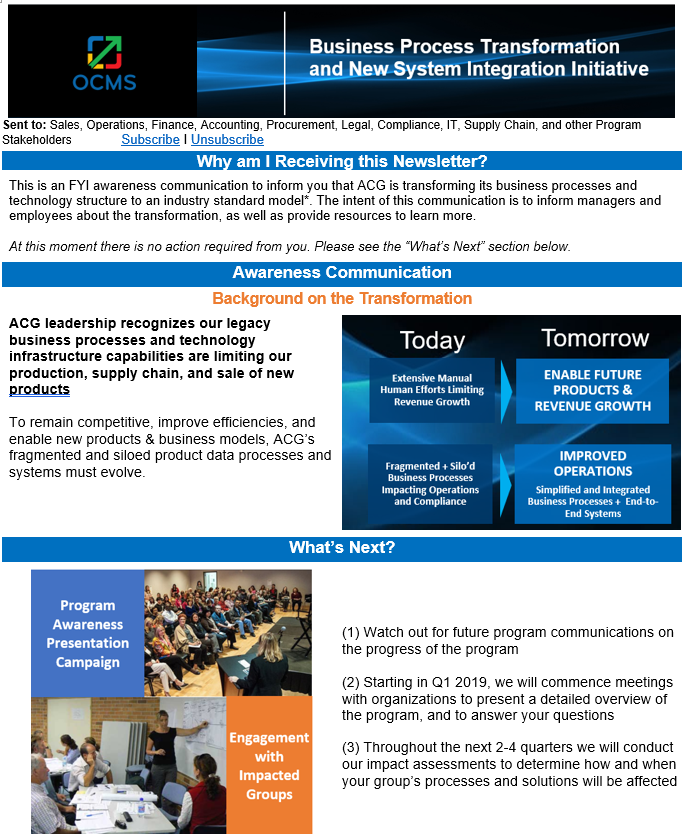
What Kinds of Messages Can you Communicate Using a Newsletter?
Sample communications include:
- Quarterly/monthly/annual/periodic business update communication
- Product releases
- New system/tool
- Change to business culture or direction
- Program kick-off
- Customer service enhancements
- Program status updates
- Implementation roadmap
- Awareness
- Impacts
- Completed milestones
- Kudos & recognition
- Heads-up / what’s next
- How and where to get help
- Training communications
- Go-live & post-go-live messages
Where possible, make sure to customize your newsletter based on the targeted audience. For example, verbiage and wording used in newsletter communications to Sales, Finance, and Accounting will be slightly different from communication broadcasts sent to IT or Operations.
Likewise, your communication plan sample newsletter going to B2B customers about a new product launch will likely highlight different selling points than one going to B2C customers.
You want to include verbiage that the reader can relate to. If you send a communication to Sales that is filled with technical jargon, for example, your audience will not relate and will quickly disregard your communication.
Two-Way Communication Strategy
As part of your comms plan, you should include a two-way communication strategy that involves both “Telling” and “Listening.”
- Telling is communicating to people
- Listening is hearing what these same people have to say
Change Managers, Program Leads, and Communication Specialists often communicate using a Telling strategy where all they do is communicate to their target audience. They don’t often involve the Listening component which involves hearing what people at the grassroots level are saying about what is being communicated.
By applying a Telling and a Listening strategy, you are communicating and also getting valuable input that will allow you to gauge the success of your communications.
Your Listening strategy should involve meeting with Change Champions, Super Users, Managers, and other stakeholders to gather what they are hearing from people at the grassroots level. What are front-line employees saying, and how are they reacting to what was communicated?
How are customers reacting to communication? Is there support or resistance to what is being communicated?
What is a communication plan delivery channel for two-way communication?
It can be any channel that allows you to both Tell and Listen. This can include channels such as:
- Team messaging (MS Teams, Slack, etc.)
- In-person meetings
- Virtual meetings
- Live chat on a website
- Phone calls
3×5 Leadership Communication | Sample & Template
Your communication guidelines template should also include 3×5 regular updates to key stakeholders, impacted managers, senior executives, and any other senior project resources.
As the name implies, a 3×5 communication strategy involves providing a succinct update using three columns:
1. What you achieved
2. What you are working on
3. What you plan to do next
Each of these three columns will list five achieved, in-progress, and planned activities, respectively.
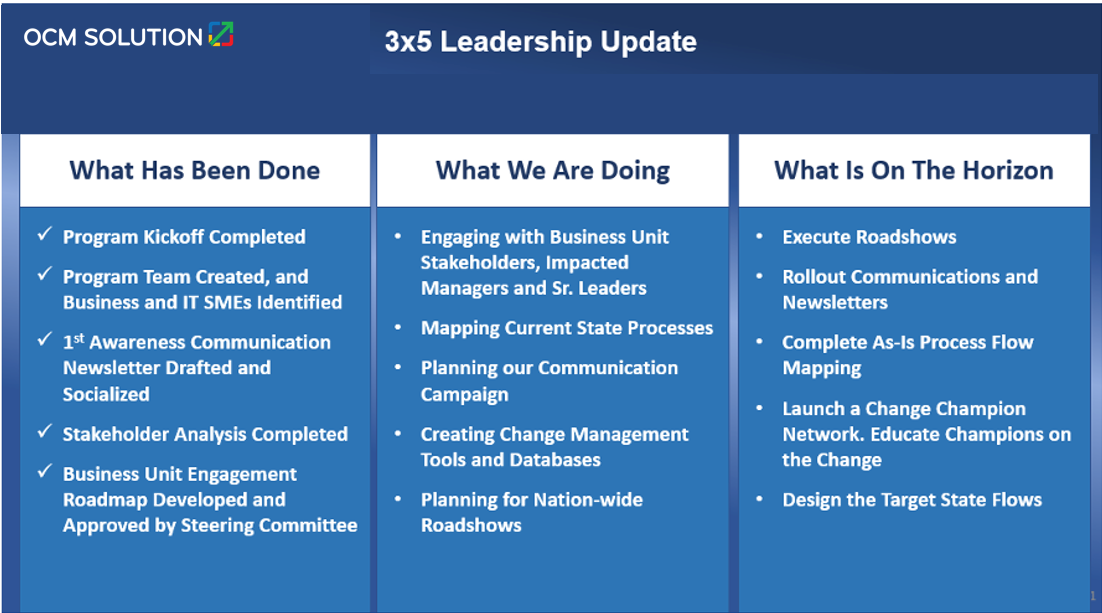
Start your free OCMS Portal software trial to download all our free communication resources.
When communicating a change to senior leaders, and project management leads, they generally like to receive communication that is succinct and presented from a high-level perspective. When leaders desire more detailed information, they prefer to be the ones asking for such details versus you sending them a very detailed first communication.
You will immediately lose the attention of most senior leaders if you send them communication that has too many details that they don’t have time to sift through. This is why including a 3×5 as part of your change management comms plan or project communication plan example is highly recommended.
FAQs – Internal Communication Employee Engagement
Proactively addressing frequently asked or anticipated questions about a project can help you address fear, concerns, or confusion upfront before it turns into project resistance.
When reviewing communication plan objectives examples, you should identify some questions you believe people would ask and answer those on an FAQ page. Add to this page as you receive actual questions from targeted internal and external audiences.
You can have one FAQ page that includes all frequently asked questions and answers, or you can have individual pages. Irrespective, this page(s) should be maintained regularly, and kept up to date with frequently asked questions and provided answers.
Also, the best project communication practice is to include a link at the bottom of every communication that you send out that points people to your FAQs page.
This will help drive end-user traffic to the FAQ page(s).
Sample FAQ Page
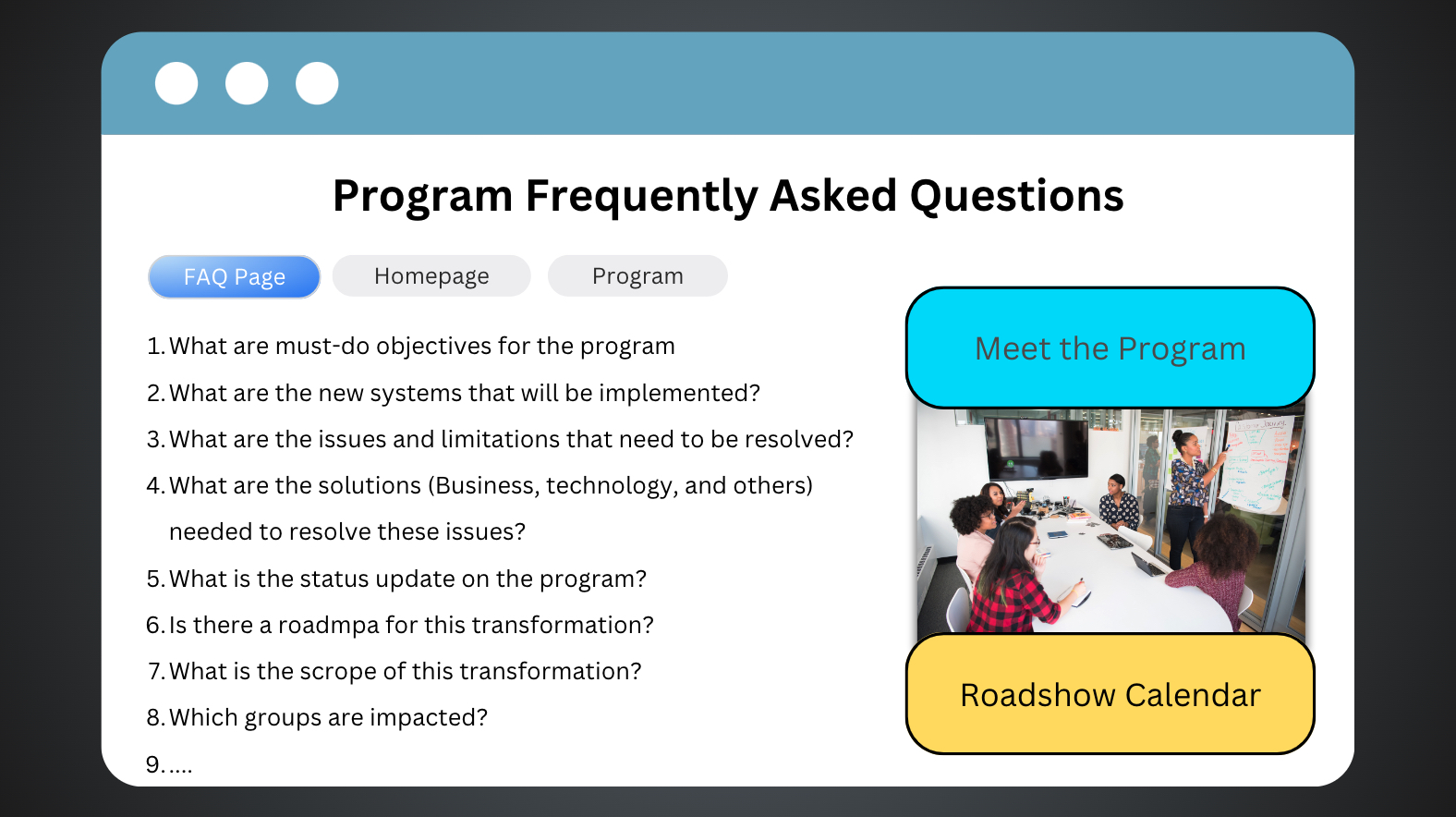
The FAQ page(s) should be published and maintained on the firm’s internal or external blog and should be accessible to all target audience groups. Using SharePoint or another internal platform that requires special access and approvals will not be ideal for external audiences.
Open access provides the broadest level of access to all target audience groups.
If you need to ensure exposure to customers and external parties, then post it on the company’s public site (you might need to work with Corporate HR or legal to get approval for this). Confidential level information should never be posted on an FAQ page, irrespective of whether the page is a public or an internal page.
Internal Communications Intranet/Blog Communication
In addition to, or separate from an FAQ page, you should also have an internal page or site where content can be posted that focuses on the project or initiative.
Use this dedicated project site to communicate progress and awareness. Upload communication videos, project documents, or artifacts that end-users can view or read. You can also upload training content and use the page as a repository for presentation and training documents.
Alternatively, you can also use SharePoint, Dropbox, or other collaborative platforms as your centralized program repository. However, as mentioned in the section above, if you need all impacted end-users to be able to quickly access the repository without having to go through approval hoops, then effective communication strategies call for using a platform that is easily accessible by all impacted end-users.
Videos & Recordings Strategy to Include in Your Internal Communications Plans
Where possible, you should record your team’s end-user meetings, training, coaching, workshops, and other touchpoints, and post the recordings on the firm’s website, on your FAQ page, or on the project page for stakeholders to view.
If you are using video and audio tools (Microsoft Teams, Cisco Webex, etc.) these platforms generally come with recording features. You should record your meetings and post the information on the project site.
Posting videos as communications for events and product promotions can also be very effective. People retain more information for longer when they see it in video format rather than text only. This makes video an important part of any communication and engagement plan example that is focused on customers or leads.
► Communication Plan Template Example in the OCMS Portal’s Comms Tool
OCMS Portal’s Internal Communication Strategy Tool and Free Internal Comms Templates
Are you looking for a place to keep all your comms plan details in one place? Need communication & messaging software that allows you to collaborate with your team? How about a communication plan sample with a step-by-step checklist included?
The OCMS Portal all-in-one change management software includes a great tool to use for internal communications. It includes a best-in-class communication plan template, samples, a communication plan checklist, a 360-degree interactive analytics view of your communication strategy, and much more.
Simplify and Optimize Your Change Management and Communication & Engagement Today!
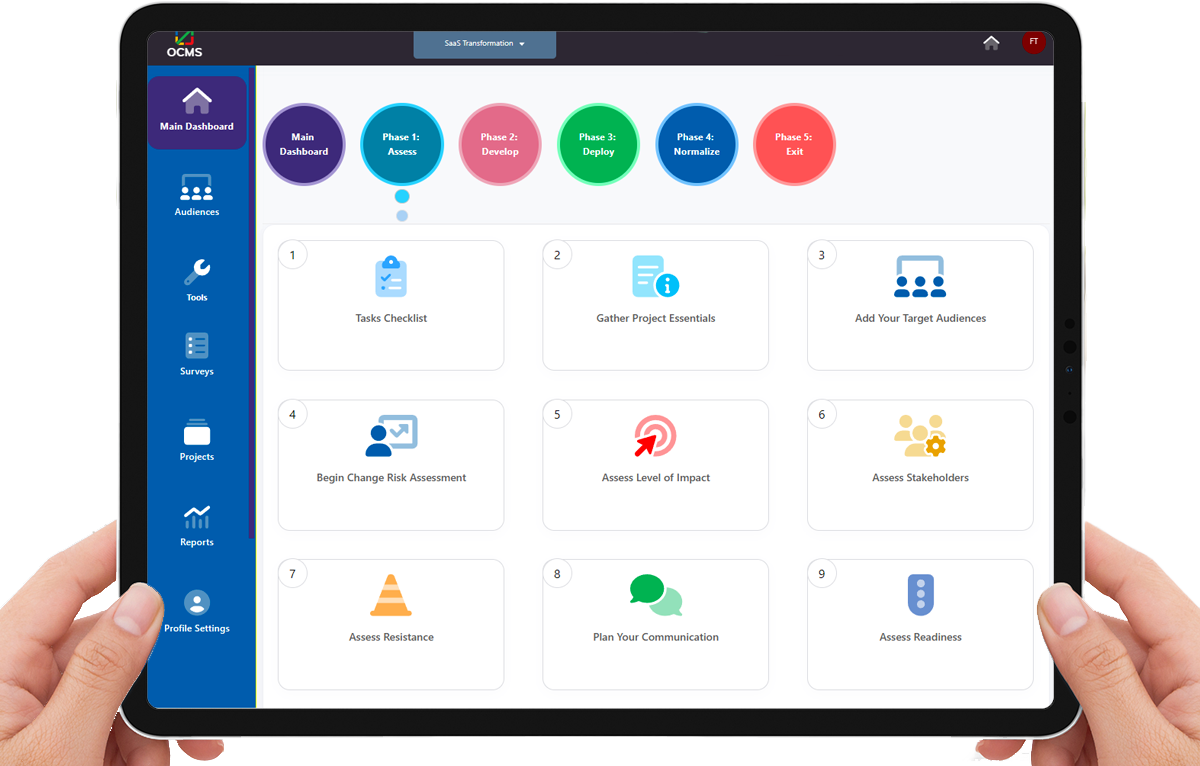

Do you have any questions about the internal brand communication? Please reach out and let us know.
Conclusion – Example of Internal Communication Plans & Templates
Over the last decade in my role as a Senior Change Management Program Manager, I have delivered end-to-end change management capabilities for large, complex business transformations. Something I have identified again and again is that different groups and individuals have different preferences for how they consume communication.
By applying a multi-prong approach as part of your project and change management communication plan, you drastically increase the success of your communication efforts.
The aim of this communication plan and strategic guide presented above is to provide you with a step-by-step overview of the best communication plan practices that you need to be aware of, to help increase your communication successes.
Best of luck in your communication planning and delivery. Let us know if you have any questions or comments.
Communication & Messaging Planning Software Tool
A communication plan is a document that outlines the communication strategies, activities, and deliverables that will be used to communicate with a targeted audience including both internal and external audiences. The best communication plans include the list of targeted communication audience groups, as well as the success matrix and indicators that will be used to track the communication successes.
The purpose of a communication plan is to document the approach that will be used to design, develop, implement and track the effectiveness of a communication program. As such, a communication plan should include the who, what, when, and how of the communication campaign.
The initial step to creating the best communication plan is to first determine your communication objectives. And next, you will want to identify the list of communication audiences, what they need to know, how they need to be communicated with, and what KPIs you will use to track the success of your communication campaigns.
The initial step to creating the best communication plan is to first determine your communication objectives. And next, you will want to identify the list of targeted internal and external communication audience groups, what they need to know, how they will be communicated with, and what KPIs you will use to track the success of your communication program.What is a Communication Plan?
What Should be Included in a Communication Plan?
What Does a Communication Plan Look Like?
How to Write an Effective Communications Plan
Note: Content on OCM Solution's ocmsolution.com website is protected by copyright. Should you have any questions or comments regarding this OCM Solutions page, please reach out to Ogbe Airiodion (Change Management Lead) or the OCM Solutions Team today.
External sources: stock.adobe.com, https://products.office.com/en-us/sharepoint/collaboration, https://www.ls.graphics/free/free-pixel-4-and-pixelbook-go-mockup, https://www.pexels.com/photo/people-on-a-video-call-4226256/

